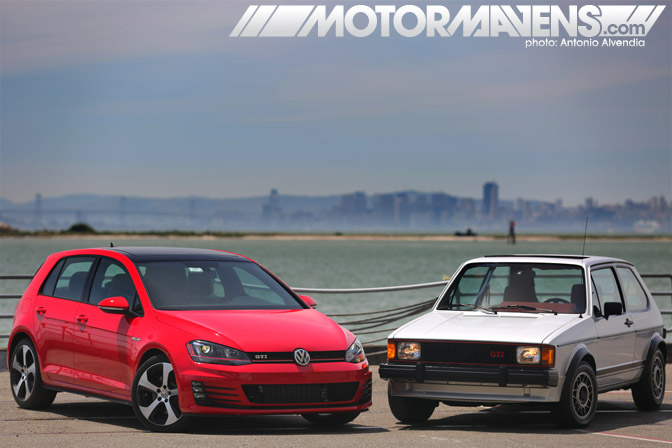
This year, Volkswagen is celebrating the 40th Anniversary of the popular VW Golf – the best selling European car of all time! More than 30 million Golf models have been sold since the Golf Mk1 went on sale in May 1974 in Europe (the car made its debut in the United States as the Volkswagen Rabbit in December of the same year). Seven generations later, the successful formula remains the same: compact, yet elegant styling; space-efficient interior design; small displacement yet powerful engines; and responsive front-wheel-drive handling.
While on a short trip to San Francisco, I had the unique opportunity to test drive both the all new 2015 Volkswagen Golf Mark 7 and a 1984 Golf GTI Mark1. What an awesome experience that was!

When debuted, the Golf marked a revolution for Volkswagen. The car’s water-cooled inline engines were placed transversely, driving the front wheels, whereas the Beetle’s air-cooled, horizontally-opposed engine lived at the back, driving the rear wheels. The car was very successful in the U.S., selling more than 100,000 units in its first full year from February of 1975, the best of any new import.
The first full-production Golf rolled off the line in Wolfsburg, Germany in March 1974 and was in German Volkswagen dealerships that May. The Golf wasn’t the first VW to have a transversely mounted engine driving the front wheels, however: the K70, a design taken from NSU, was first, followed by the Scirocco and the Passat. With the launch of the Golf, the new technology found its way into Europe’s highest volume vehicle class.
The Golf had a big task to fulfill: taking over from the Beetle, the world’s most successful car at the time. However, the combination of Giorgio Giugiaro’s design, the spacious interior, the car’s practicality, and its nimble handling won the market over to such an extent that the one-millionth Golf was produced in October 1976.
Initially, the cars came with a 1.5-liter engine that made 70 horsepower, but a diesel model was added to the lineup for 1977. This 1.5-liter diesel four-cylinder engine produced just 48 hp, but also delivered incredible EPA estimated fuel economy ratings of nearly 50 mpg on the highway and nearly 40 mpg in the city.
The Rabbit models produced in the U.S. differed from their German Golf cousins in having square instead of round headlights, larger taillights, color-matched interiors, and a softer suspension. The Golf was an innovative force in the compact hatchback class. In fact, the original GTI was the reason the term “hot hatch” or “hot hatchback” was invented in 1976.
Over time, the Rabbit received a larger 1.7- liter engine rated at 74 hp and a 1.6-liter, 52 hp diesel. And, of course, the GTI made its debut in the US in 1983, featuring a 90-hp, 1.8-liter version of the fuel-injected four- cylinder engine. The global sales figures added up: Volkswagen sold 6.99 million first-generation Golf models. In the U.S., about 1.5 million Golf derivatives found buyers. The Golf had proved itself a worthy successor to the Beetle.
Klaus Bischoff, Chief Designer for the Volkswagen brand since 2007, says: “The step from Beetle to Golf was truly revolutionary. Creatively, the Volkswagen designers changed from a round to an angular form, thanks to Giorgio Giugiaro’s legendary design. The main design elements of the Golf I, such as the silhouette of the upright, massive C-pillar, the prominent wheelarches, and the horizontal front with a slim grille and downwardly protruding headlights are in every Golf to the present day.”

Although the exterior DNA of the Golf GTI remains relatively similar throughout the years, the interior is completely different – with the exception of the golf ball-shaped shift knob in the center console.
The 1984 Golf (Rabbit) GTI that I test drove came with a very 1980s looking red interior. As an owner of several 1980s cars myself, I appreciated how spotless the interior was! The color looked awesome – very retro and stylish as well. I’d personally prefer to have some additional color contrast in the interior, but this is how they did things in the 1980s.

The headliner and carpet were both reddish-maroon, and were in mint condition! I could hardly believe the car I was driving was THIRTY YEARS OLD, based on the condition of the interior. However, I was reminded of the car’s age very quickly once I experienced the super heavy manual steering rack. Don’t get me wrong – I own several cars with manual steering racks, but this one felt particularly heavy. This is a good thing when you’re at speed, because nobody likes a wobbly steering feel at high speeds. However, when you’re trying to maneuver into a parking space, the stiff manual steering can be a bit of a sweat generator on a hot day. No problems though – I recently started going to the gym again! Haha!
The factory 1984 GTI seats are pretty damn amazing. The leg bolsters are pretty tall, holding you in place like an expensive Recaro SRD reclining bucket seat might. The side bolsters are sporty, yet comfortable, and the seat itself was covered with a subtly obnoxious red-on-burgundy striped fabric that screams 1980s. I love it! The back of the seats were covered in vinyl – a smart choice that would allow car owners to keep their seats clean a lot easier over the years.
Check out the super thin, yet amazing looking bright red floormats. They were made from a thicker pile loop material for durability. They look damn cool too.

I’m not a huge fan of the factory econobox Volkswagen 4-spoke steering wheel. In my opinion, these types of four spoke steering wheel designs are the antithesis of a sports minded steering wheel. In fact, I’m starting to yawn a little bit just looking at the photo of the wheel pictured – in my opinion, it says, “I belong in a grocery getting econobox.” No bueno.
If I owned one of these cars, the first thing I’d do is most likely swap out the steering wheel in favor of a 1980s Momo wheel with a vintage Volkswagen logoed horn button.

Same thing goes for the head unit, which was a single DIN Craig radio. Being that this car is a 1984 Volkswagen, I’d much rather prefer to listen to 1980s music using an authentic German tape deck – Blaupunkt anyone?
The golf-ball shaped shift knob, however, is pure perfection. I appreciate the pun (and the fun) intended. The shift knob and shifter both felt very solid, and I’m sure the Mark1 GTI’s 5speed close ratio transmission appreciated the accurate, smooth shifts. I love round shift knobs – they fit the hand much better than the sculpted anatomic knobs. I appreciate the simplicity of the round shift knob design, even on newer cars. I’m extremely happy to see that Volkswagen has retained this shift knob design for its Mark7 Golf. Brilliant!

Mounted low in the center console are a set of factory equipment VDO gauges in mint condition. You can tell the gauges are proper European spec, with the water temp meter reading in Celsius rather than Fahrenheit (Wait. Isn’t fahrenheit a German word? Sounds like one..?).

Here’s an interesting thing I noticed while putting my camera bag in the trunk of the Mark 1 GTI – the reservoir in the trunk! Interesting placement.

Once I strapped in to the driver seat of this Rabbit GTI, I had a BLAST driving the car. Most people would complain that the car is slow compared to modern standards, and it is. Most people would complain that the car is noisy compared to normal standards, and the suspension is bumpy. It is ALL those things, and I think it’s great! I had so much fun blasting through the gears on the mean streets of Richmond CA, while revving up the 1780cc 8valve inline four cylinder motor and letting that exhaust sing!

Let’s be honest here. The Mark1’s shocks and springs are a LOT softer than I’d prefer, but they did just fine for stock suspension components. I’d still prefer to swap out the shocks for something stiffer (especially up front), and put lower springs on the car with a more aggressive spring rate. However, for a 30 year old car, the little GTI was surprisingly nimble, and literally made me laugh out loud like a teenager driving a car for the very first time. What a great car – and since Volkswagen has been making these things and improving upon its original design for 40 years now, you can only imagine how many advancements they’ve made in the newest Mark7 Golf GTI!

I was able to test out the 2015 Golf GTI very, very briefly. I don’t feel as if I had enough seat time in the car, but I really loved how it felt so far!
Stay tuned to MotorMavens for an updated story with more focus on the Mark 7 Golf! I can’t wait to get back behind the wheel of that car!
:: Antonio Alvendia




























What was the milage on the mk1? That interior seriously looks like it’s never been sat in!
@kyushakai: Man, I didn’t even check the mileage! I wish I did, because you’re right – the condition of the interior was amazing!
Thanks for sharing that amazing article. I think Volkswagen is the best brand today and has been in the past. Its been a journey of credibility and service for Volkswagen. You can trust their product with not just superficial beauty but with the power they posses in the core. Too good
@Brian_87! Thanks for the comment! I’ll be honest here – my background is geared more towards Japanese cars, but the more and more I learn about Volkswagen and its heritage… and the more I experience its new cars, the more I like it!
I can’t wait to get more seat time with the Golf GTI Performance Package and the Golf R!